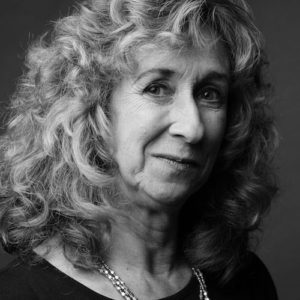 I’m a sucker for authors with great personal stories, and Sy Montgomery shares this on her website:
I’m a sucker for authors with great personal stories, and Sy Montgomery shares this on her website:
To research her books, films, and articles, Sy Montgomery has been chased by a silverback gorilla, embraced by a Giant Pacific Octopus, and undressed by an orangutan. But she is perhaps best known for her 14-year love affair with Christopher Hogwood, a runt piglet who grew to a 750-pound great Buddha master.
So, yeah. We’re having Sy in for this month’s Author Interview. No doubt about it!
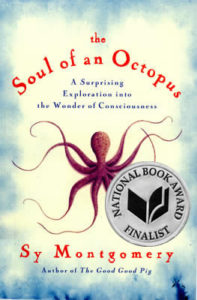 Here’s a bit more bio-wise about Sy. She’s a naturalist, documentary scriptwriter, and author of more than twenty acclaimed books of nonfiction for adults and children, including the National Book Award Finalist The Soul of an Octopus and the memoir The Good Good Pig, a New York Times bestseller. The recipient of numerous honors—including lifetime achievement awards from The Humane Society and the New England Booksellers Association—she lives in New Hampshire with her husband, border collie, and flock of chickens.
Here’s a bit more bio-wise about Sy. She’s a naturalist, documentary scriptwriter, and author of more than twenty acclaimed books of nonfiction for adults and children, including the National Book Award Finalist The Soul of an Octopus and the memoir The Good Good Pig, a New York Times bestseller. The recipient of numerous honors—including lifetime achievement awards from The Humane Society and the New England Booksellers Association—she lives in New Hampshire with her husband, border collie, and flock of chickens.
And since I’m a world-class animal fan, I know we’ll get along famously.
With that, let’s get to it!
RVC: Some of the picture book authors I interview have a zillion different books about a zillion different topics. You seem to have gone another way and committed more fully to a specific focus. What’s the common denominator with the kidlit—all the books, really—that you write?
SM: Everything I write, for adults and kids, is inspired by and in service to animals.
RVC: Clearly you must’ve had a meaningful early encounter with animals. What was it?
SM: I don’t even remember this, but my parents told me: When I was younger than two, my parents took me to the Frankfurt Zoo, in Germany (where I was born–not in the zoo, but in the city of the Frankfurt!) I broke free of my parents’ hands for a few moments and disappeared. When they found me, I had toddled into the hippo pen—right next to a 3,000-pound hippo, considered the most dangerous animal in Africa.
My parents weren’t happy, but clearly, both the hippos and I were fine about it. I always felt comfortable with animals—far more so than with most people.
RVC: That’s amazing. When did you go from being an animal pal to becoming a writer (not that you can’t do both, as your career demonstrates so well)?
SM: When I began to read, my father, an Army General and my hero, used to help me read animal stories in The New York Times. Back then, in the 1960s, most of the animal stories in the newspaper were about how animals were going extinct due to poaching, pollution, and human overpopulation. I was horrified! Even as a little kid, I realized that people were at fault here, but the good news was that people could also be the solution. If only people knew what was happening! If only people understood that animals have thoughts and feelings, and love their lives as we love ours!
Up to that point in my life, I’d wanted to be a veterinarian—to this day, it’s a vocation I consider almost holy. But I realized as a child that I might be able to help more animals as a writer by getting people to care about animals.
RVC: You were a triple major in college. How did that happen, and how did it prepare you for a life as a writer (and adventurer)?
SM: I just was so hungry for knowledge about EVERYTHING—which is a great thing for a writer. My majors were magazine journalism, French language and Literature, and Psychology. I would have quadruple majored, adding biology, but the school wouldn’t let me!
RVC: I’ve been there. I finished 2.5 undergraduate majors myself and would’ve kept accumulating more had someone not told me, “Hey, just go to graduate school, silly!” Which I did.
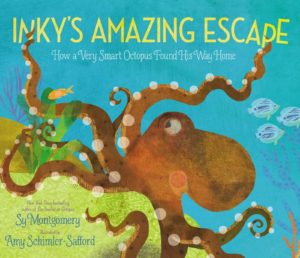 Let’s get to your books. I’m a big fan of Inky’s Amazing Escape: How a Very Smart Octopus Found His Way Home. How did that book come about?
Let’s get to your books. I’m a big fan of Inky’s Amazing Escape: How a Very Smart Octopus Found His Way Home. How did that book come about?
SM: In 2015, my book for adults, The Soul of an Octopus, was published, and became a surprise national (and later international) bestseller and National Book Award finalist. So when a very smart octopus who lived in a New Zealand aquarium escaped from his tank and slid down a drain back into the ocean he’d come from, all sorts of news outlets turned to me for comment. It seemed like this would make a fabulous book for children!
RVC: Besides telling Inky’s escape story in that book, you share interesting octopus facts. They’re such interesting creatures—how do you know which things to share, and how much is too much? That’s something many nonfiction picture book writers struggle with.
SM: Kids absolutely LOVE octopuses! Really, space on the page—not my young readers’ interest—was the limiting factor!
RVC: Why are octopuses so special to you?
SM: I love how these creatures are so different from us that you’d have to go to outer space or science fiction to find something more different from us—and yet, you can become very good friends with an octopus. We both like to play!
RVC: I’m now second-guessing myself, grammatically speaking. Should I be saying “octopi” instead?
SM: “Octopuses” is the correct plural, though “octopi” sounds cooler!
RVC: Gotcha–thanks!
Let’s talk about the octopus book you just mentioned–The Soul of an Octopus: A Surprising Exploration into the Wonder of Consciousness. Wow, what a book! Honestly, it’s the first one of yours I ran across. I’ll bet you hear that a lot.
SM: Thank you! That bo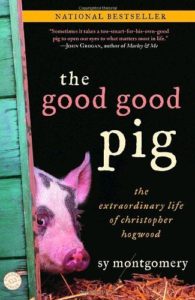 ok sure had legs! (or arms!) It was my second national bestseller. The first was The Good Good Pig, a memoir (for adults) of my life with a 750-pound pig who was really a great big Buddha master.
ok sure had legs! (or arms!) It was my second national bestseller. The first was The Good Good Pig, a memoir (for adults) of my life with a 750-pound pig who was really a great big Buddha master.
RVC: What was the most difficult aspect of writing that book?
SM: I had such fun researching and writing The Soul of an Octopus. The only difficult part was my own self-doubt that I wasn’t worthy of telling my octopus friends’ stories. But when I can’t trust myself, I can trust my teachers, in this case the octopuses and others (including people) who showed me that if I have a soul, an octopus has one, too.
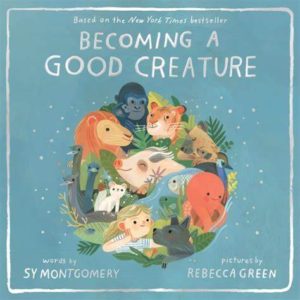 RVC: You wrote about an octopus as well in the New York Times bestselling book How to Be a Good Creature: A Memoir in Thirteen Animals. How did you go about adapting that 208-page into a 40-page picture book, Becoming a Good Creature? What was the process?
RVC: You wrote about an octopus as well in the New York Times bestselling book How to Be a Good Creature: A Memoir in Thirteen Animals. How did you go about adapting that 208-page into a 40-page picture book, Becoming a Good Creature? What was the process?
SM: In addressing the struggles that adults face—finding a passion, building a family, learning to forgive, to survive despair, to start life anew–How to be a Good Creature dealt with some mature themes (child abuse, suicide) that weren’t appropriate for very young children. But we must remember that even very young readers face equally dramatic challenges in their lives. I thought about these, and about what animals a young child might like to meet. Clearly I needed to put lions and tigers and sharks in there, too! And hyenas! So the picture book has fewer icky grown-up problems and more animals.
I was very lucky to have Kate O’Sullivan, my fabulous editor, to help me with this book. (And Becca’s artwork is so amazing that I honestly think this title would have sold if all I’d done was copy 40 pages from the phone book.)
RVC: Rebecca Green illustrated both the adult version and the picture book. You’re right–she’s very good. What appeals to you most about her work?
SM: The tenderness that she shows in depicting the animals is what I love most about her work. She doesn’t portray animals as cartoons. Many books about octopuses, for instance, have the head in the wrong place. That drives me nuts. Becca’s respect and affection for the animals shines through every illustration.
RVC: It seems to me that you think that we should—need to, in fact—interact more meaningfully with the animal world.
SM: Absolutely! Limiting your friendships to just one species is just as impoverishing as eating only one food, or listening to only one piece of music.
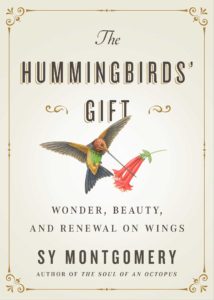 RVC: You’ve got a new book coming out in a few weeks—The Hummingbirds’ Gift: Wonder, Beauty, and Renewal on Wings. Congrats on that! While it’s not a picture book, it’s definitely kid friendly. In all your experience putting that book together, what surprised you the most?
RVC: You’ve got a new book coming out in a few weeks—The Hummingbirds’ Gift: Wonder, Beauty, and Renewal on Wings. Congrats on that! While it’s not a picture book, it’s definitely kid friendly. In all your experience putting that book together, what surprised you the most?
SM: In that book, I had the great blessing of working with hummingbird rehabilitator Brenda Sherburn helping to raise and release orphaned baby hummingbirds. What amazed me is that these tiny delicate babies—they are little more than bubbles wrapped in light–can survive at all. Even for a mother hummingbird, raising a baby is a Herculean task. But for a person to do it? Consider this: they have to be fed every 20 minutes or they starve. But feed them too much, and they can actually pop.
RVC: That’s amazing. What’s the biggest misconception people have about hummingbirds?
SM: Most people love hummingbirds, and don’t realize how many we inadvertently kill. They are killed in shockingly large numbers by our pet cats. They are killed by pesticides we use on our lawns and gardens. (They don’t just need nectar; they need hundreds of tiny bugs every day to survive.) They are killed by pollution, by climate change, by the destruction of their habitats for homes and offices and stores. So it was a great privilege to try to fight that tide by working with Brenda to literally help bring some nearly-dead hummingbird babies back to life!
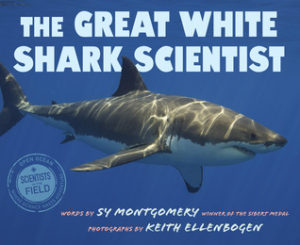 RVC: I’m a shark fan, too, so of course I really enjoyed your The Great White Shark Scientist, which is part of the Scientists in the Field series that includes other titles of yours such as Condor Comeback and Amazon Adventure. What is the most important thing people should know or understand about sharks?
RVC: I’m a shark fan, too, so of course I really enjoyed your The Great White Shark Scientist, which is part of the Scientists in the Field series that includes other titles of yours such as Condor Comeback and Amazon Adventure. What is the most important thing people should know or understand about sharks?
SM: More people are killed by toilets than sharks. More people are killed by toasters than sharks. More people are killed by doctors’ and nurses’ mistakes than by sharks. But nobody wants to get rid of toilets, toasters, or medical professionals!
RVC: You likely don’t know this, but I live quite close to Mote Marine Laboratory & Aquarium, which was launched in 1955 as the Cape Haze Marine Laboratory. Who started it? Why, Dr. Eugenie Clark, a.k.a. “The Shark Lady.” Did you ever get a chance to talk sharks with her?
SM: Oh my gosh, I would’ve loved to! But I’m very lucky to be good friends with the star of The Great White Shark Scientist, Dr. Greg Skomal, who is the lead researcher documenting the recent and exciting population increase of great whites off Cape Cod’s iconic shores.
RVC: One last question before the final part of the interview. The New York Times has called you “equal parts poet and scientist” and The Boston Globe says you’re “part Indiana Jones and part Emily Dickinson.” Which of those four compliments pleases you the most?
SM: Though I’m a huge fan of Emily Dickinson’s, I think Indiana Jones had more fun!
RVC: Okay, Sy. Here we go. Put on your penguin party hat, because it’s time for THE SPEED ROUND! Zebra-fast questions and zoomy cheetah answers, please. Are you ready?
SM: You bet!
RVC: Craziest thing you ever ate while chasing animals all around the world the way you do?
SM: I drank rice wine flavored with the corpse of a fetal deer out of a human skull in Borneo while researching my first book.
RVC: Which animal would you most want to see write a book about YOU?
SM: Octavia the Giant Pacific Octopus. I would love to know what she thought about me, even though my mouth was in the wrong place (should have been in my armpits), I had two too few hearts (octopuses have three) and I could neither change color nor shape. Yet she loved me. Why?
RVC: If you had a theme song that describes your life right now, it’d be….
SM: A‑wimoweh, a‑wimoweh, a‑wimoweh, a‑wimoweh (“The Lion Sleeps Tonight”)
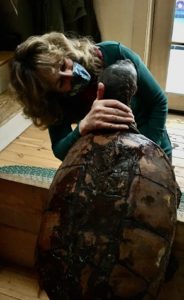 RVC: If you could ask any one animal any one question—which animal, and which question?
RVC: If you could ask any one animal any one question—which animal, and which question?
SM: I would ask Fire Chief, a 40-pound, 60–80 year-old snapping turtle who I work with (and adore) at Turtle Rescue League, what is his experience of time. (He was injured when he was hit by a truck crossing a street, and we are working with him to strengthen his back legs. I’m attaching a picture just for you!
RVC: A recent great picture book about animals is…
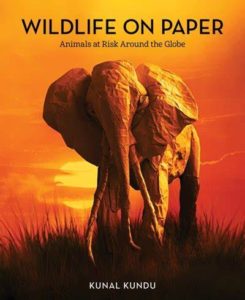 SM: Wildlife on Paper: Animals at Risk Around the Globe by Kunal Kundu. The book was inspired by his son, and features artwork he creates from crumpled paper.
SM: Wildlife on Paper: Animals at Risk Around the Globe by Kunal Kundu. The book was inspired by his son, and features artwork he creates from crumpled paper.
RVC: What’s the best thing a child ever said about one of your books?
SM: I want to spend my life helping animals just like you!
RVC: Thanks so much, Sy! This was a a REAL treat.


Love hearing Sy’s regular visits on our local Boston Public Radio station WGBH!
The photo with Fire Chief is amazing. Is he not likely to exercise his jaws in a giant SNAP?
I worried about the same thing! But Sy knows what she’s doing for sure.